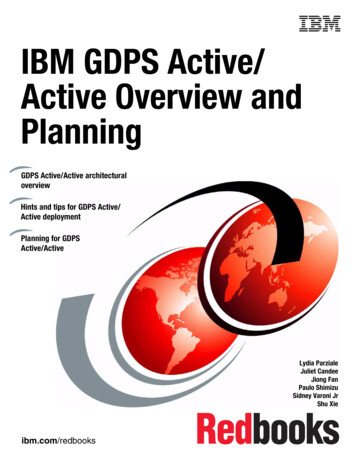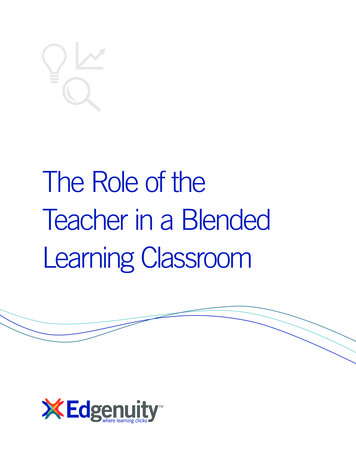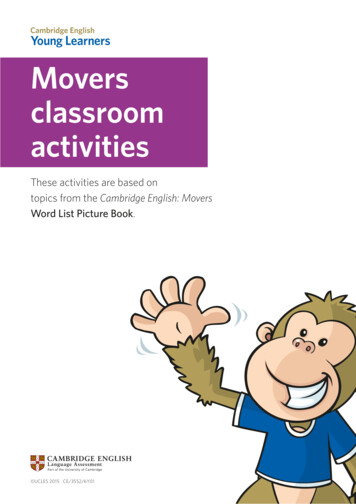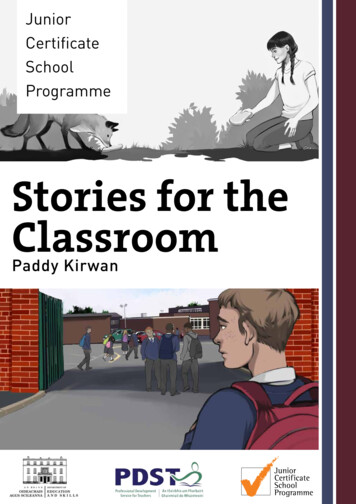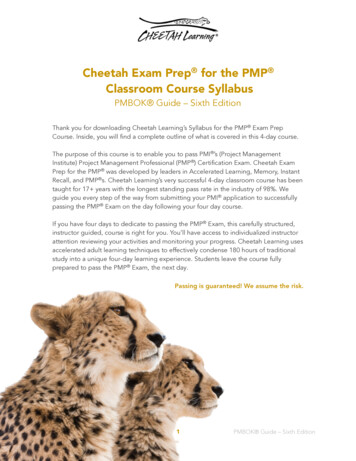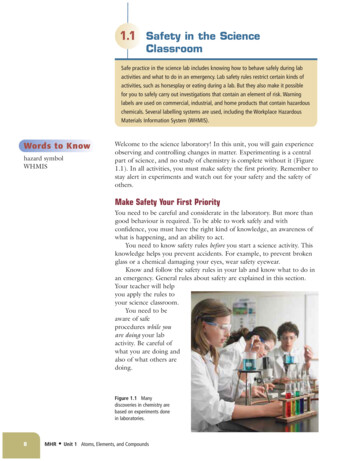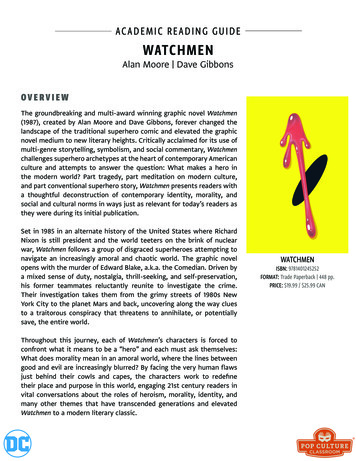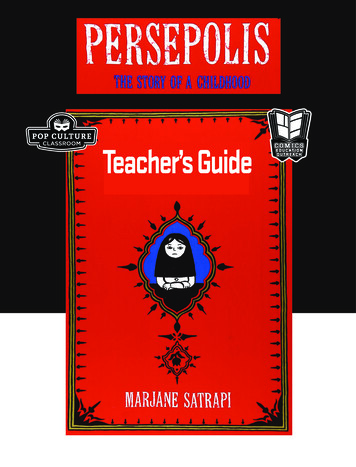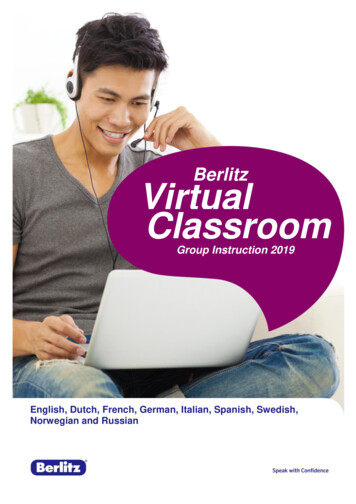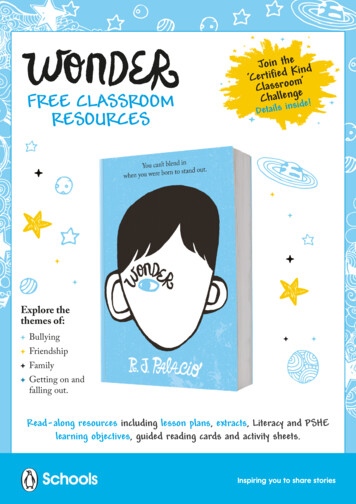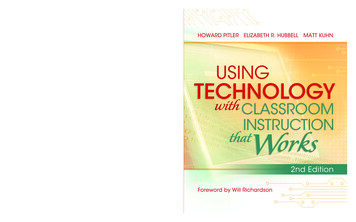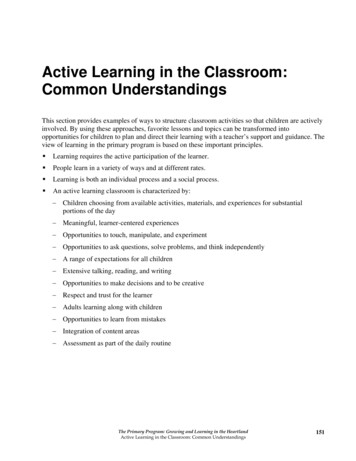
Transcription
Active Learning in the Classroom:Common UnderstandingsThis section provides examples of ways to structure classroom activities so that children are activelyinvolved. By using these approaches, favorite lessons and topics can be transformed intoopportunities for children to plan and direct their learning with a teacher’s support and guidance. Theview of learning in the primary program is based on these important principles. Learning requires the active participation of the learner. People learn in a variety of ways and at different rates. Learning is both an individual process and a social process. An active learning classroom is characterized by: Children choosing from available activities, materials, and experiences for substantialportions of the day Meaningful, learner-centered experiences Opportunities to touch, manipulate, and experiment Opportunities to ask questions, solve problems, and think independently A range of expectations for all children Extensive talking, reading, and writing Opportunities to make decisions and to be creative Respect and trust for the learner Adults learning along with children Opportunities to learn from mistakes Integration of content areas Assessment as part of the daily routineThe Primary Program: Growing and Learning in the HeartlandActive Learning in the Classroom: Common Understandings151
Active Learning Through Play and ExplorationPlay is the fundamental, natural, universal activity of children.Play is intrinsically motivated for personal satisfaction and is away of learning. It is the expressive activity resulting from thechild’s desire to make sense of the world.Children learn through the process of play because of an innerdrive to explore, experiment, and discover. The integration ofthe child’s intellect, emotions, and inner drive promotes thedevelopment of the whole child. This integration may beaccomplished through the provision for high quality play andexploration experiences in the primary years. As childreninteract with objects and materials, with people, and withideas and thoughts, the information gained through thisexperience is explored, tested, reflected upon and representedin a variety of ways.The Development of PlayAs children develop intellectually, the types of play inwhich they engage reflect this development. Play may becategorized as practice or functional, constructive,symbolic, or as games with rules (Bergen, 1988).Pretending enables children to representproblems and practice solving them, to askquestions and learn about the world interms they can understand. Play is selfmotivated practice in meaning-making; itsthemes are repeated over and over until thechild is satisfied that she’s got this figuredout. In the process she is acquiring learningstrategies, knowledge, and skills.Practice of Functional PlayPlay of this type is characterized by (early to laterprimary): Increased motor skill The desire to master physical challengesJones & Reynolds, 1992 Repetition to acquire and refine physical skills Repetition of gross and fine motor activities (ridebikes, bounce balls) often with numerous variations,over and over Practice play activities serving as rehearsals of specific skills to be used in games or sports Rough and tumble play Experimenting with new materials and combining known materials in new ways to solveproblemsConstructive PlayPlay of this type is characterized by (early to later primary): Use of materials to make a particular product representing objects, ideas, or processes (paintings,drawings, three-dimensional creations) Combining of constructive and symbolic play (creating a poem, dramatizing a production)152The Primary Program: Growing and Learning in the HeartlandActive Learning in the Classroom: Common Understandings
Combining a constructive and socio-dramatic play (creating environments to play out games,e.g., forts, boats, tents) Making collections, organizing, examining, discussing, trading and displaying collections(stamps, models, shells, rocks)Symbolic PlayPlay of this type is characterized by (early to laterprimary): Playing out what can be imagined The ability to give objects properties that suitthe needs of play (a block becomes a car,telephone, hair dryer) The assignment of roles (“You be the sister.”)becoming more elaborate and sophisticated Fantasy play becoming more internalized(drawing, daydreaming) Becoming more “miniaturized” (Barbie dolls,action figures, Playmobile people) Role experimentation based on experiences thatare not concrete or direct (futuristic stories) Playing with language through jokes, parodies,riddles, and nonsense verseGames with RulesPlay of this type is characterized by (early to later primary): Inability to adhere to rigid rules Rules viewed as fluid, flexible, and easily adapted toimmediate needsCooperative games, in which Rules being decided upon spontaneouslychildren do not have to usestrategies that require outwitting Playing at games rather than following actual rulesor beating one another, are more Inability to understand the point of rulesdevelopmentally appropriate for Increasing control of actions, behavior, and reactionsthese ages as well as morewithin established limitscongruent with the social goals Emergence of acceptance of prearranged rulesof more early childhoodclassrooms. Increasing involvement in computer games andKamii & DeVries, 1980simulations, board games, and card games Understanding of sports-related games (four-square,tether ball) Many games have characteristics more similar to socialconventions rather than competitions (Mother, Mother,May I?; Red Light, Green Light; and King of the Hill) Games challenges being combined with role enactment of familiar stories Individual and team competition becoming more evident Cooperation with others becoming a necessity for competitionThe Primary Program: Growing and Learning in the HeartlandActive Learning in the Classroom: Common Understandings153
Teachers create environments wherein children are actively invited to seek knowledge throughexploration and play. Children have an active voice in initiating learning needs. Teachers respond tothese needs by planning learning experiences that are enjoyable, challenging, intellectuallyinteresting, and which allow the learner freedom to make choices, self-direct learning, andcollaborate with the teacher in the active construction of knowledge.Playful approaches to higher order cognitive skills such as critical thinking areespecially important during the elementary years as children begin to be able to ‘playwith ideas,’ testing their thinking and comparing it with that of their peers.Opportunities for creating playful challenges that have comfortable level of risk arecrucial during this age period and should be available at school.Bergen & Oden, 1988Social InteractionThe rich environment and quality of interaction provided by theteacher can enhance experiences designed to foster intellectualdevelopment.The teacher can enhance children’s thinking and languagedevelopment by encouraging the rich possibilities contained in thedialogue accompanying the child’s active involvement in meaningful,developmentally appropriate learning experiences of all kinds.Because learning is accommodative, the teacher frequently plays adirect teaching role, structuring specific situations within which achild may learn. The teacher’s questions and comments to each childplay a critical role in extended thinking.The younger the children,the more the content ofinteraction should relateto their own first-handexperiences and realenvironment. Withincreasing age andexperiences, children canand should beencouraged to developtheir understanding ofindirect experiences.Katz & Chard, 2000When a child is expected to learn or practice independently, activitiesselected are usually within her/his developmental level.This does not mean, however, that teachers wait for the child to develop and mature. Teachers muststimulate the cognitive functions that are in the process of developing. With support or assistance, incollaborative and supportive situations, a child is capable of much more than working alone. Thus, tofacilitate learning, teachers work with children or set up situations in which children work together.Vygotsky’s explanation of the zone of proximal development, the “learning zone,” illustrates howpeople are able to stretch beyond their individual capabilities toward more mature cognitivefunctioning when they learn together. The zone of proximal development is:“ distance between the actual developmental level as determined by independentproblem solving and the level of potential development as determined through problemsolving under adult guidance or in collaborations with more capable peers.”Vygotsky, 1980154The Primary Program: Growing and Learning in the HeartlandActive Learning in the Classroom: Common Understandings
Support to IndependenceFrustration LevelChildren are not yet ableto work at this level evenwith support or assistance.Zone of ProximalDevelopment“Learning hildren can do withsupport or assistance fromother children or adultsthose things just beyondtheir level of developmentAppropriate forcooperative learning,group or partner activities,peer tutoring, modeling ordirect instruction, guidedpractice.Children canindependently doactivities withintheir level ofUtilizes social interactiondevelopmentAppropriate forindividual discoveryactivities andindependent practiceFeelings of uncertaintyand questioning; state ofchallenge and growthFeelings of(disequilibrium)confidence andcompetence(equilibrium)“The zone of proximal development defines those functions that have not yet matured but are in theprocess of maturation, functions that will mature tomorrow but are currently in an embryonicstate.”Vygotsky, 1980The Primary Program: Growing and Learning in the HeartlandActive Learning in the Classroom: Common Understandings155
Developing Thinking through Meaningful Learning ExperiencesIn order for children to become thoughtful learners, they must be invited to actively engage inworthwhile activities that capture their interest and imagination. Thinking is an integral part of allaspects of the curriculum, not something to be taught in isolation as an “add on.”All children require opportunities to learn as much about how thought processes work and abouttheir own thinking as possible so as to expand their repertoire of thinking strategies. Teachers canencourage learners to greater sophistication in the use of strategies for thinking, but for learners tointernalize each strategy, they must reflect upon its use and limitations personally.Fostering children’s thinking abilities requires a supportive classroom environment in which mutualrespect and cooperation, risk-taking, error, and individual differences are valued. Teachers planexperiences and guide the learners in making connections, but it is only when learners are providedwith time and encouragement to talk about, represent, and reflect upon their experiences that theytruly gain understanding.A Framework for ThinkingTo make effective program decisions which enablechildren to inquire, represent, and reflect upon theirthinking, the teacher considers thinking in its broadestsense. The following model may provide a usefulframework for examining thinking.Thinking with Information and ExperienceGrowth of thinking is a function of prior knowledge,information, and experience. It is the richness andvariety of these experiences which shape children’sthinking. Information and misinformation, concepts andmisconceptions, have equal influences in developingthought.Expanding a child’s variety of learning experiencesexpands his or her opportunities for trying new ways ofthinking.156Thinking About Solving Worthwhile ProblemsThinking With Thinking SkillsThinking forwise, thoughtful, Strategiesand ethical action Processes OperationsWays of Thinking Experiences Information ResourcesMetacognition: encompasses awareness and understandingabout Different ways of thinking Dispositions or behaviors that affect the quality ofthinking Monitoring and evaluating thinking processes so thatimprovements can be made Thinking extrapolated to other situationsThe Primary Program: Growing and Learning in the HeartlandActive Learning in the Classroom: Common Understandings
Thinking ProcessesExamples of specific thinking processes familiar to all teachers are: gJudgingJustifyingClarifying Goal alyzingCritiquingDefining InquiringFocusingThinking processes can be taught. Analyzing andbreaking thinking into discrete units may be helpfulfor instructional and diagnostic purposes. However,whatever the dominant thought process, manyskills and strategies are inevitably involved in anyone operation. Therefore, the teacher does not relyon any one approach or program to teach childrenabout thinking. The teacher’s instruction is guidedby broad, interactive conceptions of thinkingprocesses. Such conceptions acknowledge thecomplexity of thinking as well as the variedapplications of thinking.Thinking About Meaningful ProblemsThinking does not occur unless there is somethingworthwhile and of interest to think about. Becausethinking strategies learned in a specific situation may not transfer automatically to a new situation,instruction is designed to help the learner build connections.Some examples of important bridges that must be built through learning experiences are thosebetween: Past experiences and present challenges Reason and imagination Criticism and creativity Teaching and learning Decision-making and moral judgment School life and real lifeIn designing instructional opportunities, the teacher links the thinking processes required in schoolwith the thinking processes needed in “real” life. The teacher invites students to think aboutproblems relevant to their own lives, to the lives of others, and to society in general. This presentschildren with rich opportunities for using a wide range and variety of thinking processes.The Primary Program: Growing and Learning in the HeartlandActive Learning in the Classroom: Common Understandings157
The Application of ThinkingHow thinking is applied is of critical importance.Contemporary society is faced with problems oftremendous complexity. Thoughtful actions basedon good judgments as well as a concern for longrange effects are desired. Ultimately, we seek acombination of development of responsibility andwise action.MetacognitionThe teacher teaches children about thinking aswell as ways to apply thinking strategies.Metacognition is the term used for this process. It encompasses awareness and understanding aboutdifferent ways of thinking; dispositions or behaviors that affect the quality of thinking; monitoringand evaluating thinking processes so that improvements can be made; and thinking extrapolated toother situations.The goal of teaching thinking strategies is to develop thoughtful learners—children who havelearned different ways of thinking, can apply them to real life problems, and can call upon the kindof self-criticism that guides wise action. How we apply thinking is of critical importance.Ultimately, the quality of learning and the wisdom of actions are determined by how the thoughtprocesses are put to use.Fostering the Development of Thinking StrategiesThe teacher fosters the development of thinking by engaging children in meaningful learningexperiences which encourage: Inquiry Representation ReflectionInquiryChildren who are provided with opportunities to ask questions of themselves, classmates, teachers,and other adults will develop skills that promote lifelong learning. The role of the questioner,formerly that of the teacher, needs to be jointly assumed by the learner so questions can be asked,solutions sought, and learning enhanced. As children are encouraged to ask questions for the sake oflearning, their interest in and responsibility for their own learning increases. The environment inwhich mistakes are accepted as a natural part of learning allows each child to take risks and developthe confidence to become an “inquiring voice” (Watson, Burke, & Harste, 1989). In considering thedevelopment of a thoughtful, questioning learner, the inquiring teacher might ask:158The Primary Program: Growing and Learning in the HeartlandActive Learning in the Classroom: Common Understandings
Does the child generate questions?Is the child committed to his or her questions?Does the child ask different kinds of questions?Does the child like finding out?Does the child shift thinking as a result of newknowledge gained through asking questions?Does the child show joy in learning?Being human entitles you to aninquiring voice, and it’s from askingnew questions and old questions forwhich current answers seemunsatisfactory that real learningemanates.Watson, Burke, & Harste, 1993RepresentationChildren acquire knowledge as they think about and try tomake sense of their world. They represent this knowledge as they give form to personal thoughts andideas and communicate their thinking. Children need repeated opportunities to represent theirexperiences and thoughts in a variety of ways.Levels of RepresentationRepresentation may occur at three levels: concrete, transformational, and symbolic/abstract.Children represent their thinking in a variety of ways at each level (e.g., talking, which is abstract,begins before the age of two). Concrete Representation—direct representation using overt physical action and/or threedimensions Transformational Representation—indirect representation, resembles the concrete, uses twodimensions Symbolic/Abstract Representation—symbols bear no direct resemblance to the conceptrepresentedAs children explore a variety of forms of representation, the teacher provides them withopportunities to select how they might wish to represent their learning. In this way, children developan appreciation of representation not as a “decoration,” but as a way to reflect upon andcommunicate their thinking. In this way, too, the teacher assists each child to make connections andtransfer ideas from one context to another, matching appropriate representational strategies tospecific situations (e.g., “I want to know what you understand about light.” Appropriate strategies:experiment, model, art, photography, written report, collection, etc.).The Primary Program: Growing and Learning in the HeartlandActive Learning in the Classroom: Common Understandings159
Representation of KnowledgeForms of RepresentationLEVELSConcrete ImitationDramatic and socio-dramatic playClay, sand, block constructionDance, creative and rhythmic movementThree-dimensional models includingconcrete graphs and maps Creative dramaticsPuppetryMusicResponsive movementCounting with objects DrawingPaintingCollagePicturesPictorial signs Pictographic writingGesturesTally marksPictorial graphs Talk or related expressive formsConventional writing (alphabetic or related expressive forms)Symbolic paintingsMathematical symbolsMusical notationSymbolic signsSymbolic graphs and mapsOFREPRESENTATION Trans formational Symbolic/AbstractChildren have opportunities to more closely examine their own thinking as they are encouraged tochoose different forms of representation and explain these choices. Choice of representational formsalso enables more learners to represent thinking in ways that match individual learning styles. Aschildren have opportunities to select ways of representing their knowledge, teachers haveopportunities to evaluate children’s thinking and to examine each child’s ability to communicateknowledge meaningfully.ReflectionChildren require time and encouragement to reflect upon their thi
Children have an active voice in initiating learning needs. Teachers respond to these needs by planning learning experiences that are enjoyable, challenging, intellectually interesting, and which allow the learner freedom to make choices, self-direct learning, and coll
